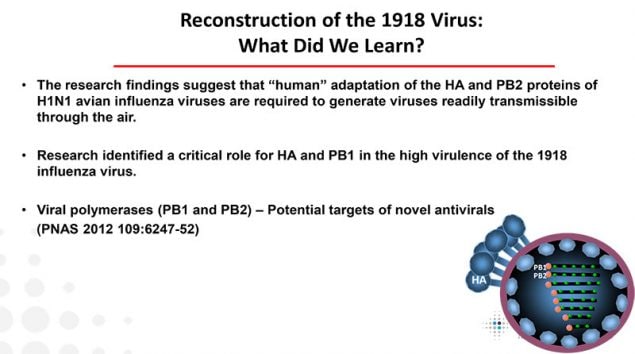Why was it so important to study the 1918 virus?
Dr. Tumpey: Because the coding sequences of the 1918 viral RNA segments did not reveal obvious genetic features that had been associated with virulence, so it was important to study 1918 recombinant viruses to better understand the genetic markers responsible for virus replication and virulence of this pandemic strain. Thus, I felt like the molecular characterization of the reconstructed 1918 pandemic influenza virus shed light on why this virus was such a killer.

This image lists lessons learned from the study of the reconstructed 1918 virus at CDC and why it was so deadly.
What did you learn about why the 1918 pandemic virus was so deadly?
Dr. Tumpey: We found that the HA and PB1 virus genes of the 1918 virus are essential for maximal replication and virulence. With these data in hand, some scientists felt that these virus genes could be a potential target for a new generation of anti-influenza A drug development. We feel that the quality of the 1918 virus work and end result of the project was remarkable.
How do laboratory safety precautions factor into your job and that of your branch?
Dr. Tumpey: It is increasingly important that staff adhere to biosafety and biosecurity requirements. I am a Select Agent principal investigator (PI), and as PI, I am responsible for full compliance with the policies, practices and procedures put forward by the Select Agent program and Office of the Associated Director of Laboratory Science and Safety (OADLSS). Actually, this important responsibility extends to all aspects of biological safety involving the laboratory environment and all people who enter the BSL-3E space.
What role did you play during the 2009 H1N1 pandemic?
Dr. Tumpey: My role during the 2009 H1N1 pandemic was to perform laboratory experiments with 2009 H1N1 influenza viruses to see how well the virus spread and how severe it was as well as to help evaluate immunity to this novel virus. This helped us assess the potential harm this virus could cause. This was important since the full clinical spectrum of disease caused by 2009 H1N1 influenza viruses and their transmissibility were not completely understood. CDC’s Influenza Division was the first to show that in contrast to seasonal influenza viruses, 2009 H1N1 influenza viruses caused increased morbidity, replicated to higher titers in lung tissue, and were recovered from the intestinal tract of intranasally inoculated ferrets. Interestingly, we found similarities between the 2009 pandemic H1N1 virus and the 1918 H1N1 virus. This was based on several serological studies of the 2009 H1N1 viruses that provided evidence for the presence of cross-reactive antibodies to the 1918 H1N1 virus. Using this information, we demonstrated that vaccination with the seasonal 2010-2011 vaccine (containing the 2009 H1N1 virus) induced neutralizing antibodies to the 1918 virus and protected ferrets against 1918 influenza virus infection. This was a simple study that showed that the seasonal inactivated influenza vaccine that most of us receive would provide protection against the reconstructed 1918 virus which, as a select agent, is considered to pose both biosafety and biosecurity threats.
Do you have any final thoughts on how the lessons learned from your research can help us prepare for the next pandemic?
Taken together, influenza vaccines and antiviral drugs represent critical tools to reduce the burden of influenza virus infection, and they feature prominently in pandemic preparedness and response frameworks. Through the identification of which 1918 virus genes are important for morbidity and the development of vaccines and antivirals, it is clear that reconstruction of the 1918 virus has provided invaluable information towards pandemic preparedness efforts.
Thank you for your time, Dr. Tumpey!
This concludes our CDC expert interview. For more information on Dr. Tumpey’s work and the 100-year anniversary of the 1918 pandemic, please see Dr. Tumpey’s Flu Fighter profile article and CDC’s 1918 pandemic commemoration page.
Pages: 1 · 2
More Articles
- National Archives Records Lay Foundation for Killers of the Flower Moon: The Osage Murders and the Birth of the FBI
- 2024 Tax Filing Season Set for January 29; IRS Continues to Make Improvements to Help Taxpayers
- Nichola D. Gutgold - The Most Private Roosevelt Makes a Significant Public Contribution: Ethel Carow Roosevelt Derby
- Oppenheimer: July 28 UC Berkeley Panel Discussion Focuses On The Man Behind The Movie
- Congressional Budget Office: Federal Budget Deficit Totals $1.4 Trillion in 2023; Annual Deficits Average $2.0 Trillion Over the 2024–2033 Period
- Remarks by Secretary of the Treasury Janet L. Yellen at the Bureau of Engraving and Printing Facility in Fort Worth, Texas
- At "Toward an Inclusive Recovery," a research seminar sponsored by the Board of Governors of the Federal Reserve System, Washington, D.C.
- GAO High Risk List, Public Health Preparedness: *HHS Should Address Strategic National Stockpile Requirements and Inventory Risks
- "Henry Ford Innovation Nation", a Favorite Television Show
- Center for Strategic and International Studies: “The Future Outlook with Dr. Anthony Fauci”






